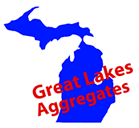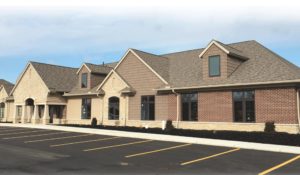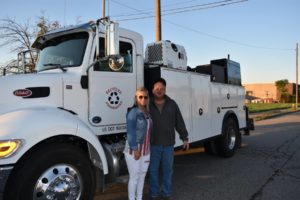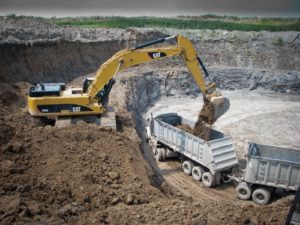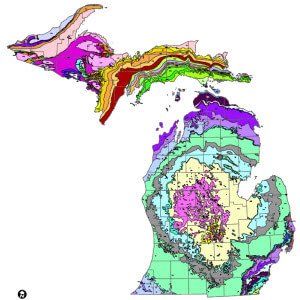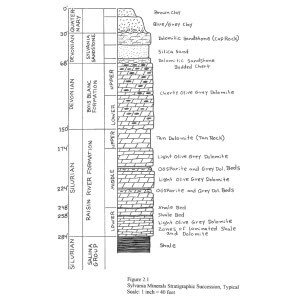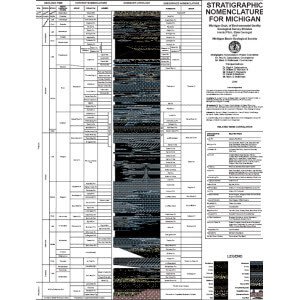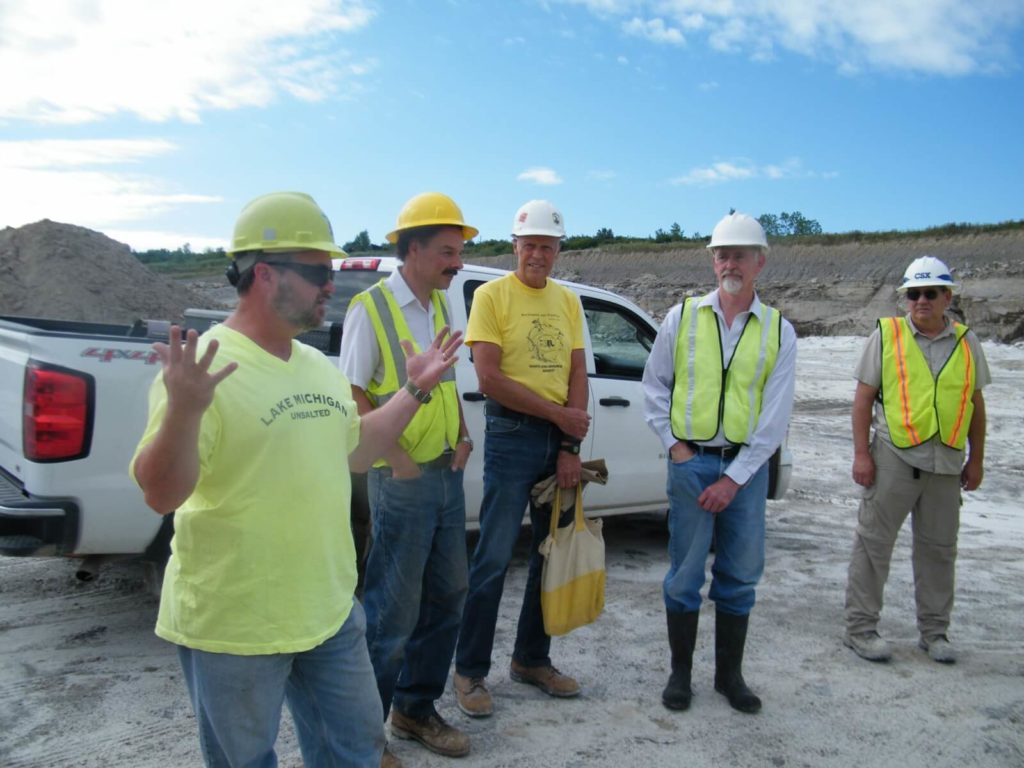Sylvania Minerals Quarry
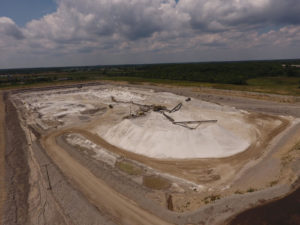
Sylvania Minerals is a sandstone and limestone quarry located in the Village of South Rockwood, in north east Monroe County Michigan.
The quarry and plant began operations in 1998, and operates on a 600 acre site. The quarry mines clay, dolomitic limestone, and sandstone. The clay is used for a variety of land balance earth work projects and landfill applications. The sandstone is a high purity silica sandstone that is used for the manufacture of glass. The dolomitic limestone is used to produce a variety of construction aggregates used in road construction and pavement.
Sylvania Minerals Quarry
5699 Ready Road
P.O. Box 406
South Rockwood, MI 48179
| Phone: | 734-783-7400 |
| Fax: | 734-379-0311 |
Hours
| Weekdays | 6:00am to 5:00pm |
| Saturday | 6:00am to 2:00pm |
MDOT ASI 58-0013CA
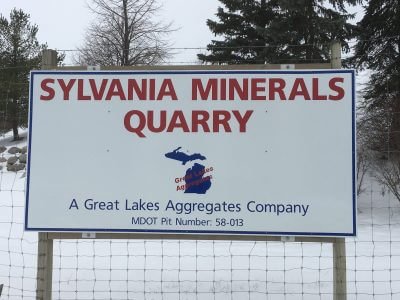
Community Outreach
Hundreds Attend Library’s Opening
From Monroe News January 17, 2017: This past weekend, Great Lakes Aggregates was honored at the grand opening of the South Rockwood Branch Library. The $1.5 million complex paid for by Sylvania Minerals features a 5,000 square foot library and media center along with a 3,500 square good community room and kitchen. The signature piece…
Read MoreOperating Engineers 324 in Labor Day Parade
On Monday, September 5th, Operating Engineers 324 joined other labor unions, politicians, working people and partners from around the state to take part in the annual Labor Day parade in Detroit. The parade route runs from Michigan and Trumbull in Detroit’s oldest neighborhood to Cobo Center.
Read More2017 MAA High School Video Contest
The Michigan Aggregates Association is once again conducting a high school video contest that promotes and highlights various aspects of the aggregate industry. The purpose of the video contest is to …
Read More![]()
![]() Credit cards only, no cash or check payments.
Credit cards only, no cash or check payments.
Limestone Material
Approximate size: 1 1/2″ x 0 with fines
Common applications: Road base, shoulders, driveways
Approximate size: 1″ x 0 with fines
Common applications: Road Base, shoulders, driveways
Approximate size: 1 1/2″ x 0
Common applications: Common fill, pipe bedding, drainage
Approximate size: 3/4″ x 0
Common applications: Common fill, walking/bike paths
Approximate size: 3/8″ x 0
Common application: Common fill
Approximate size: 1′ x 1/4″
Common applications: Pipe bedding, drainage
Rip-Rap Product
Product uses: Retaining walls, sea walls, road runoff drains, landscaping
Product uses: Retaining walls, sea walls, road runoff drains, landscaping
Product uses: Retaining walls, sea walls, road runoff drains, landscaping
Product uses: Retaining walls, sea walls, road runoff drains, landscaping
Product uses: Retaining walls, sea walls, road runoff drains, landscaping
Available upon request
Product uses: Retaining walls, sea walls, road runoff drains, landscaping
Available upon request
Commercial/County Material
Approximate size: 1 1/2″ x 1/2″
Common applications: Pipe Bedding, drainage, driveways
Approximate size: 3″ x 1″
Common applications: Common fill, driveways
Approximate size: 1 1/2″ x 0 with fines
Common applications: Road Base, shoulders, driveways
Approximate size: 3/8″ x 0
Common application: Drainable fill
Other Products
No Posts Found.
Asphalt Splits Product
Product use: Hot Mix Asphalt Mixes
Product use: Hot Mix Asphalt Mixes
Product use: Hot mix asphalat mixes
Product use: Hot mix asphalat mixes
Approximate size: 1/2″ x 0 with fines
Product use: Hot mix asphalt mixes
Safety Data Sheet
Limestone, Crushed Stone
Table of Contents
- General Identification
- Hazard Identification
- Composition of Ingredients
- First Aid Measures
- Fire Fighting Measures
- Accidential Release Measures
- Handling and Storing
- Exposure Controls/Personal Protection
- Physical and Chemical Properties
- Stability and Reactivity
- Toxicology Information
- Ecologial Information
- Disposal Considerations
- Transport Information
- Regulatory Information
Geology
Exposed in the Sylvania Minerals quarry is Pleistocene glacial till, sandstone of the Devonian age Sylvania Sandstone Formation, and dolomitic limestone’s of Devonian and Silurian age.
The glacial till lies on top of the underlying bedrock, and was deposited during the last glaciation. As the glaciers began to retreat (melt) 25,000 years ago, they deposited a thick layer of material on top of the bedrock called glacial till. The till is predominantly clay with sand, pebbles, cobbles, and the occasional boulder. Whatever was entrained in the ice sheet, which was up to two miles thick at its maximum thickness, was deposited on the bedrock as the glaciers melted.
The sandstone under the till is the Devonian Age Sylvania Sandstone. The formation was deposited on the margin of a large epicontinental sea that inundated the middle of the North American Continent 380 million years ago. The sandstone is made up of well sorted washed quartz sand, sediments typical of shoreline and eolian (sand dune) environments.
Underlying the Sylvania Sandstone is the Raisin River Dolomite, which is the formation that is mined for construction aggregates in the Sylvania Minerals quarry. The upper unit of the Raisin River Dolomite is a cherty dolomitic limestone which is generally 100 feet thick in the quarry. The lower unit of the formation is also approximately 100 feet thick, and is made up of dolomitic limestone largely devoid of chert. The sediments that make up the formation were deposited in a shallow marine environment that covered Michigan 410 million years ago.
Some interesting fossils and minerals are occasionally found in the quarry. The most common minerals are calcite and celestite. Fossils include coral, brachiopods, bryozoans, and the rare trilobite.
Sylvania Minerals hosts the Friends of Mineralogy group annually. Specimens are collected and photos are taken of the different benches, minerals, and fossils. Below is a letter from Geologist Reggie Rose describing the trip:
Friends of Mineralogy Trip to Sylvania Minerals Quarry is a Success!
A total of 29 Friends of Mineralogy collectors were in attendance July 15, 2017 at our field trip to the Sylvania Minerals Quarry in South Rockwood, Michigan. Unlike our 2016 trip, temperatures were easily bearable rising to only the low 80’s by the end of our time there (last year it was 93!). Although the temperature was cooler than a year ago, the collecting heated up this year. A lot of our collectors found nice specimens to take home. I saw more worthwhile specimens this year and took more pictures than in any single year, and maybe as many as all the years we have been there totaled together. We spent about 75 percent of the day on the upper bench where there is mostly calcite. Celestite was hard to find on the upper bench, but when it was found, the upper bench celestite specimens made the most attractive specimens. The upper bench celestite manifested itself in pockets that were filled with fine clear celestite blades. Before this article concludes, all photographed finds will be mentioned, but the real celestite dazzler from the upper bench was found by Pam Lauer (Crestline, OH). During the last part of the day Friends of Mineralogy collected on the middle bench where the rocks encased larger blue masses of celestite which was blocky, rather than in fine blades like on the upper bench.
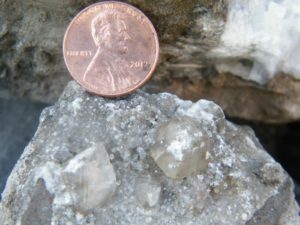
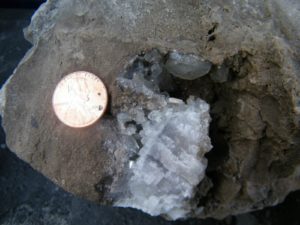
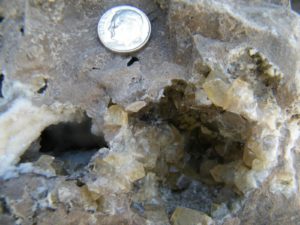
My camera lens was treated to images of three types of specimens: (a) Calcite, (b) Celestite, and (c) combo specimens of Calcite & Celestite. Keep in mind that during the course of a field trip, due to time constraints, I only get photos from a few collectors, so there are more members in the “clubs” below. I just did not get to see what everyone collected. Collectors in the “Calcite Club” were: Mike Royal (Defiance, OH), Tom Bolka (Xenia, OH), Cliff Harness (Columbus, OH), Marty Povirk (Franklin, MI) & Mick Pinka (Bellville, OH). In the “Celestite Club” besides Pam were Jeff Schaumberg (Columbus, OH), Mike Royal, Lawrence Hull (Lexington, OH) and Mick Pinka. The lone member of the “Combo Club” that I saw was Cliff Harness.
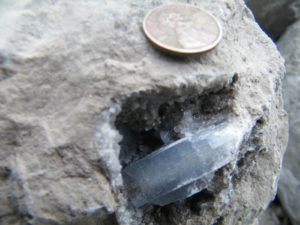
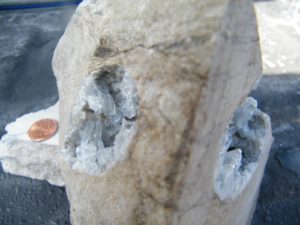
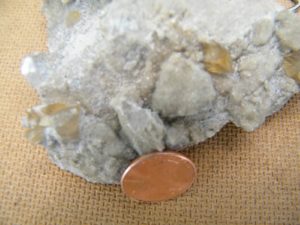
As aforementioned, the weather and collecting on this trip to South Rockwood were markedly different than last year. What was not different from last year to this year, was the excellence of our host. Bill Begley is a veteran plant manager who is not only a quarry employee, but at MSU, earned a geology degree. What is noticeably special about him is his warmth as a host, knowledge of his quarry, and safety awareness. His warmth is evident as he enjoys talking to our member collectors. His knowledge his quarry is important with regards to logistics – Bill knew when to move the Friends of Mineralogy group to the lower bench, and that is important – he knew there was not as much material for inspection as on the upper bench, so he knew when to move the group. Our move was like an orchestral conductor waving the baton at the right time. Last, but not least important, Bill is a safety expert – although we claim to have the best training of any club in the region, and some of our group members are pretty sharp on safety, Bill showed he was the sharpest safety guy in the quarry, checking on finer details like wheel chocks, condition of our equipment and positioning of collectors. Thank you for keeping us safe Bill, and thanks to Great Lakes Aggregates having FM as guests. It is through what we collect we can support the recipients of our charitable efforts. Mining companies like Great Lakes Aggregates have an interest in education in mineralogy and the geological sciences. Because of their supportive view of education and their belief that they can have a positive on the community outside the quarry through public relations efforts, it is easy to see why Bill Begley, Sylvania Minerals Plant Manager and Chris Kinney, President, Great Lakes Aggregates in a period of a few short years, become Friends of Mineralogy favorites. To view the full article in the Friends of Mineralogy Newsletter click here.
Reggie Rose
Friends of Mineralogy
FRIENDS OF MINERALOGY (FM): Mission Statement and Affiliations
WHAT IS FRIENDS OF MINERALOGY?
Friends of Mineralogy (FM) is a national organization of professional and amateur mineral collectors, founded in Tucson (AZ) on February 13, 1970. FM operates on a national level and also through seven regional chapters. FM is comprised of professional mineralogists, mineral museum curators, and amateur collectors who share a love of mineral specimens and the desire to promote understanding and appreciation of mineralogy and geology. Anyone who shares those interests may become a member of FM.
FRIENDS OF MINERALOGY MISSION STATEMENT:
FM's objectives are to promote, support, protect, and expand the collection of mineral specimens and to further the recognition of the scientific, economic, and aesthetic value of minerals and collecting mineral specimens. FM also holds as important the development of positive relationships with landowners and mine operators and is committed to safe collecting.
FRIENDS OF MINERALOGY ASSOCIATIONS:
The Friends of Mineralogy is affiliated with the American Geosciences Institute (AGI) and the Mineralogical Society of America (MSA), as well as with Rocks & Minerals and the Mineralogical Record magazines. FM is co-sponsor with the Tucson Gem & Mineral Society (TGMS) and the Mineralogical Society of America (MSA), of the annual Tucson Mineralogical Symposia. Among its activities it also sponsors awards for best articles each calendar year in The Mineralogical Record, Rocks & Minerals and extra Lapis English and gives special recognition at the February Tucson Gem and Mineral Show for educational displays that help explain an aspect of mineralogy. Both of these magazines provide FM space and publish news of its activities from time-to-time. FM in turn supports these magazines in various endeavors.
FRIENDS OF MINERALOGY COMMITMENT TO EDUCATION:
FM members do not just go into a quarry to collect nice specimens to take home. Our members like to know what they are collecting and the geologic environment in which it formed. Considering this, every field trip can be a learning experience for our members. We share this information and specimens with quarry personnel so that they can help educate young students in their area. The result is that the quarry can impact science education in their area by affiliations developed through FM field trips. At the same time, quarry personnel often share information with us about their operation, whether their quarry mines materials for cement, ag-lime, decorative stone, or road aggregate. With information coming from both sides – the geology of the field trip – and the products of the quarry's operation, all parties can share in the learning experience. FM also works closely with the Ohio Earth Sciences Teachers Association, which provides mineral samples for teachers. It is through our commitment to education and safety that we hope to develop positive relationships with host quarries.
FRIENDS OF MINERALOGY COMMITMENT TO SAFETY:
A majority of our field trips are to quarries where the host asks for MSHA hazard and safety training certification. Therefore, only those members who have completed an MSHA hazard and safety training refresher course within the past year are permitted to attend field trips where MHSA certification is asked for. If, on a given trip, a collector finds nothing worth taking home (which is rare!), when that collector leaves a quarry in good health, that collector has had a successful day. An important goal is to have everyone in our membership employ safe collecting procedures and follow the directions of our host. We feel that, because our commitment to safety is so important, this is an important first step toward developing positive relationships with our host quarries. In addition, through a program initiated by one of our members who is an associate MSHA instructor, senior Ohio Department of Natural Resources geologist, and veteran collector, we are working to standardize MSHA training tailored for collectors throughout the region of the FM Midwest Chapter (IL, IN, KY, MI, MO, and OH).
